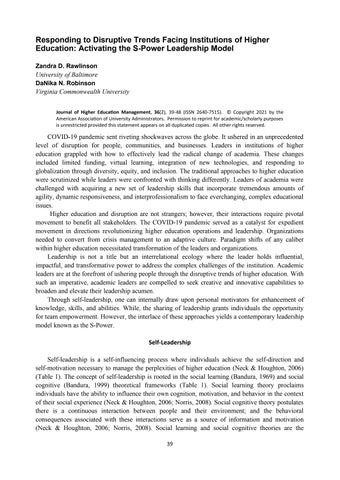Responding to Disruptive Trends Facing Institutions of Higher Education: Activating the S-Power Leadership Model Zandra D. Rawlinson
University of Baltimore DaNika N. Robinson
Virginia Commonwealth University Journal of Higher Education Management, 36(2), 39-48 (ISSN 2640-7515). © Copyright 2021 by the American Association of University Administrators. Permission to reprint for academic/scholarly purposes is unrestricted provided this statement appears on all duplicated copies. All other rights reserved.
COVID-19 pandemic sent riveting shockwaves across the globe. It ushered in an unprecedented level of disruption for people, communities, and businesses. Leaders in institutions of higher education grappled with how to effectively lead the radical change of academia. These changes included limited funding, virtual learning, integration of new technologies, and responding to globalization through diversity, equity, and inclusion. The traditional approaches to higher education were scrutinized while leaders were confronted with thinking differently. Leaders of academia were challenged with acquiring a new set of leadership skills that incorporate tremendous amounts of agility, dynamic responsiveness, and interprofessionalism to face everchanging, complex educational issues. Higher education and disruption are not strangers; however, their interactions require pivotal movement to benefit all stakeholders. The COVID-19 pandemic served as a catalyst for expedient movement in directions revolutionizing higher education operations and leadership. Organizations needed to convert from crisis management to an adaptive culture. Paradigm shifts of any caliber within higher education necessitated transformation of the leaders and organizations. Leadership is not a title but an interrelational ecology where the leader holds influential, impactful, and transformative power to address the complex challenges of the institution. Academic leaders are at the forefront of ushering people through the disruptive trends of higher education. With such an imperative, academic leaders are compelled to seek creative and innovative capabilities to broaden and elevate their leadership acumen. Through self-leadership, one can internally draw upon personal motivators for enhancement of knowledge, skills, and abilities. While, the sharing of leadership grants individuals the opportunity for team empowerment. However, the interlace of these approaches yields a contemporary leadership model known as the S-Power. Self-Leadership Self-leadership is a self-influencing process where individuals achieve the self-direction and self-motivation necessary to manage the perplexities of higher education (Neck & Houghton, 2006) (Table 1). The concept of self-leadership is rooted in the social learning (Bandura, 1969) and social cognitive (Bandura, 1999) theoretical frameworks (Table 1). Social learning theory proclaims individuals have the ability to influence their own cognition, motivation, and behavior in the context of their social experience (Neck & Houghton, 2006; Norris, 2008). Social cognitive theory postulates there is a continuous interaction between people and their environment; and the behavioral consequences associated with these interactions serve as a source of information and motivation (Neck & Houghton, 2006; Norris, 2008). Social learning and social cognitive theories are the 39




